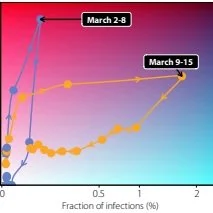Alberto Aleta, David Martín-Corral, Michiel A. Bakker, Ana Pastore y Piontti, Marco Ajelli, Maria Litvinova, Matteo Chinazzi, Natalie E. Dean, M. Elizabeth Halloran, Ira M. Longini Jr., Alex Pentland, Alessandro Vespignani, Yamir Moreno, Esteban Moro
medRxiv
December 26, 2021
ABSTRACT
Detailed characterization of SARS-CoV-2 transmission across different settings can help design less disruptive interventions. We used real-time, privacy-enhanced mobility data in the New York City and Seattle metropolitan areas to build a detailed agent-based model of SARS-CoV-2 infection to estimate the where, when, and magnitude of transmission events during the pandemic’s first wave. We estimate that only 18% of individuals produce most infections (80%), with about 10% of events that can be considered super-spreading events (SSEs). Although mass-gatherings present an important risk for SSEs, we estimate that the bulk of transmission occurred in smaller events in settings like workplaces, grocery stores, or food venues. The places most important for transmission change during the pandemic and are different across cities, signaling the large underlying behavioral component underneath them. Our modeling complements case studies and epidemiological data and indicates that real-time tracking of transmission events could help evaluate and define targeted mitigation policies.

